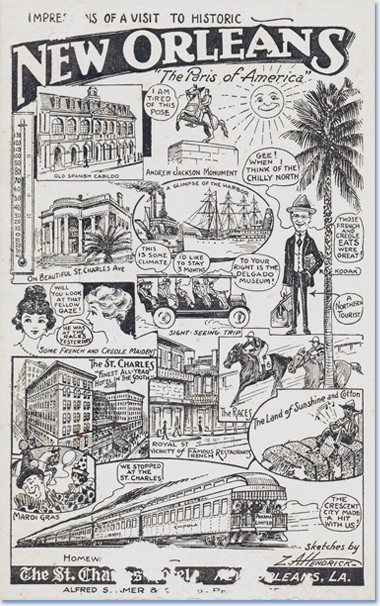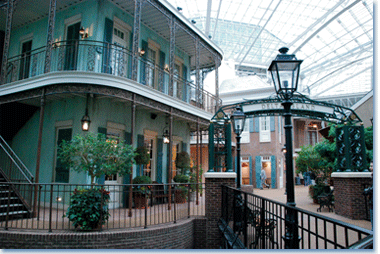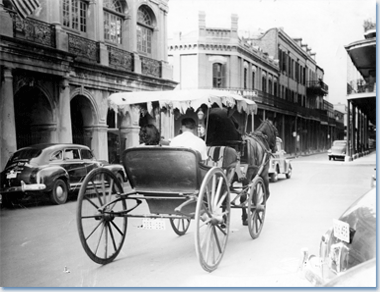 New Orleans, the host city for the 127th AHA annual meeting, is a rich gumbo of distinctive history, architecture, music, food, celebration, and sensory pleasures. Indeed, the iconography of New Orleans is the envy of most American cities: Mardi Gras, jazz, the French Quarter, Bourbon Street, Storyville, Creole cuisine, the muddy Mississippi, steamboats, voodoo, above-ground cemeteries, plantations, bayous, ghosts, streetcars, shotgun houses, second lines, café au lait and beignets, and the list goes on. Inspiring many nicknames—among them the Crescent City, the Big Easy, the City That Care Forgot, and the affectionate NOLA—New Orleans is a city in which tourism is big business. Last year alone, nearly nine million people visited the city. As one might expect, behind the city's colorful mask is a fascinating history of placemaking and an undercurrent of contestation that attends such enterprises.
New Orleans, the host city for the 127th AHA annual meeting, is a rich gumbo of distinctive history, architecture, music, food, celebration, and sensory pleasures. Indeed, the iconography of New Orleans is the envy of most American cities: Mardi Gras, jazz, the French Quarter, Bourbon Street, Storyville, Creole cuisine, the muddy Mississippi, steamboats, voodoo, above-ground cemeteries, plantations, bayous, ghosts, streetcars, shotgun houses, second lines, café au lait and beignets, and the list goes on. Inspiring many nicknames—among them the Crescent City, the Big Easy, the City That Care Forgot, and the affectionate NOLA—New Orleans is a city in which tourism is big business. Last year alone, nearly nine million people visited the city. As one might expect, behind the city's colorful mask is a fascinating history of placemaking and an undercurrent of contestation that attends such enterprises.
A City of Romance and Royalty
New Orleans emerged as a tourist destination following the Civil War. The arrival of transcontinental railroads, first-class hotels, and guides aimed specifically at tourists helped popularize New Orleans as a winter destination. New Orleans leaders, like peers in other southern cities, hoped to use tourism to entice northern investment. They crafted a romantic Old South image that, toward the close of the 19th century, relied on Jim Crow restrictions to forge the illusion of a stable racial order. African Americans became virtually invisible in promotional literature except as domestic servants or "picturesque" riverfront dockworkers. The city's business establishment exerted greater control over the city's Mardi Gras festivities, confining parades to specified routes and creating their own parading organization, the Krewe of Rex, in 1872 to act as the public face of Carnival. In the 1870s and 1880s, writers such as Lafcadio Hearn and George Washington Cable contributed to the city's emergent aura in the pages of Harper's, Scribner's, and Century Magazine. Blurring the boundary between fiction and nonfiction, they depicted a city evoking the Mediterranean or Caribbean, where a visitor could see the world by strolling New Orleans's streets. The 1884–85 World's Industrial and Cotton Centennial Exposition increased the city's popularity as a tourist destination. By that time many railroads and steamboat lines served New Orleans, bringing more than one million attendees who marveled at the world's first electrically illuminated fair. Expo promoters issued a series of tourist guides extolling the city's unique architecture, cuisine, and local lore. These guidebooks prescribed highly selective paths through the city, teaching tourists to know the city by seeing its landmarks, literally turning sites into sights.
A Licentious and Decadent City
The designation of Storyville as a sanctioned red-light district in 1897 ranks among the most important 19th-century influences on New Orleans's reputation as a tourist destination. Located near Canal Street (the Fifth Avenue of New Orleans) and the Southern Railway passenger terminal, the 20-square block Storyville made New Orleans famous as what one historian calls the "Southern Babylon." Sex was for sale around the clock at all price points in both opulent Victorian mansions on Basin Street and ramshackle shotgun houses on side streets. For 20 years, until the U.S. Navy shut down Storyville in World War I, the district added to New Orleans's growing reputation for mixing the romantic with the risqué.
 To the turn-of-the-century tourist, an ideal winter trip to New Orleans probably meant taking in the spectacle of Carnival, a night at the French Opera House, betting on horses at the Fair Grounds, a streetcar ride to Spanish Fort for a shore dinner by Lake Pontchartrain, and sampling antique shops and French restaurants in the Vieux Carré, or French Quarter. Yet the Quarter was less a focal point than today. Local leaders often lamented the shabby appearance of its townhouses, which in their eyes had devolved from proud Creole homesteads to poor immigrant rooming houses. Local interest in preservation, hewing to national patterns, seldom strayed far from "great men." The one notable campaign of the 1890s rescued the Cabildo on Jackson Square, where France ceremonially handed over New Orleans to the U.S. in 1803. Even so, national magazine writers repeatedly imbued the Quarter's buildings with value by calling them "ancient" and "picturesque."
To the turn-of-the-century tourist, an ideal winter trip to New Orleans probably meant taking in the spectacle of Carnival, a night at the French Opera House, betting on horses at the Fair Grounds, a streetcar ride to Spanish Fort for a shore dinner by Lake Pontchartrain, and sampling antique shops and French restaurants in the Vieux Carré, or French Quarter. Yet the Quarter was less a focal point than today. Local leaders often lamented the shabby appearance of its townhouses, which in their eyes had devolved from proud Creole homesteads to poor immigrant rooming houses. Local interest in preservation, hewing to national patterns, seldom strayed far from "great men." The one notable campaign of the 1890s rescued the Cabildo on Jackson Square, where France ceremonially handed over New Orleans to the U.S. in 1803. Even so, national magazine writers repeatedly imbued the Quarter's buildings with value by calling them "ancient" and "picturesque."
Preservation and Profit
With the closure of Storyville, the locus of illicit pleasures shifted a few blocks into the French Quarter and ultimately settled along Bourbon Street. Around the same time, the Quarter started filling with artists, writers, and assorted nonconformists. Gays and lesbians from around the rural South also sought refuge among the Quarter's permissive denizens. The several blocks around William Faulkner's apartment on Pirate's Alley presented a cultural and social scene not unlike that of New York's Greenwich Village. New Orleans's eccentricity and the presence of so many artistic and literary luminaries proved mutually reinforcing. Vieux Carré bohemians started the local conversation about the importance of saving French Quarter architecture, leading to the creation of the nation's first city-level historic preservation agency—the Vieux Carré Commission—in 1925. Heritage-minded newcomers restored dozens of French Quarter properties as homes in the 1920s and 1930s. Some opened their patios and donned antebellum attire during Spring Fiesta, a new celebration that joined the newly organized Sugar Bowl and tourist-focused Mardi Gras Krewes of NOR (New Orleans Romance) and Hermes as tourist magnets during the Great Depression.
 After World War II, preservationists and business interests locked horns over the proper use of the French Quarter. Preservationists decried Bourbon Street merchants of beer and burlesque. They fought the construction of new hotels, including the Royal Orleans, which mimicked the Quarter's distinctive architecture with iron balconies. Activists feared that replicas were replacing the real thing and that hotels invited large, noisy tour buses hauling thousands more tourists. Activism paid off in the form of a French Quarter hotel moratorium in 1969, but the increased hotel capacity and completion of a new convention center solidified New Orleans as a year-round destination. Further, the moratorium could stop neither clandestine inns nor the construction of Canal Street convention hotels like the 42-story Marriott, which one disgruntled newspaperman called an oversized "plastic riverboat." Meanwhile, preservationists depicting the Vieux Carré as a national treasure successfully fought a decade-long battle against a planned elevated freeway that threatened to separate the Quarter from the Mississippi River.
After World War II, preservationists and business interests locked horns over the proper use of the French Quarter. Preservationists decried Bourbon Street merchants of beer and burlesque. They fought the construction of new hotels, including the Royal Orleans, which mimicked the Quarter's distinctive architecture with iron balconies. Activists feared that replicas were replacing the real thing and that hotels invited large, noisy tour buses hauling thousands more tourists. Activism paid off in the form of a French Quarter hotel moratorium in 1969, but the increased hotel capacity and completion of a new convention center solidified New Orleans as a year-round destination. Further, the moratorium could stop neither clandestine inns nor the construction of Canal Street convention hotels like the 42-story Marriott, which one disgruntled newspaperman called an oversized "plastic riverboat." Meanwhile, preservationists depicting the Vieux Carré as a national treasure successfully fought a decade-long battle against a planned elevated freeway that threatened to separate the Quarter from the Mississippi River.
Other transformations were afoot. Beginning in the 1940s, the city's jazz tradition began to revive after years of in which musicians left the city for New York or Chicago to make it big. A growing number of jazz aficionados formed clubs, organized concerts, and opened recording studios, enhancing New Orleans's reputation as the "birthplace of jazz." Preservation Hall enshrined jazz in the French Quarter in the early 1960s, while the New Orleans Jazz and Heritage Festival, begun in 1970, culminated more than two decades of attempts to launch an enduring jazz festival. Likewise, growing tourist interest in Mardi Gras produced a spate of glitzy new parades. Owen Brennan, Jr., whose father bought Old Absinthe House (reputed rendezvous of the pirate Jean Lafitte) and Vieux Carré Restaurant (now Brennan's) in the 1940s, formed the Krewe of Bacchus in 1968. Unlike old-line krewes, which accepted only scions of blueblood families as members, Bacchus was open to anyone who could pay its dues. Bacchus and other "superkrewes" that followed staged dazzling Carnival balls and parades with Hollywood celebrity kings like Charlton Heston and Bob Hope.
Toward Tourism Dependency
Tourism moved inexorably toward the center of New Orleans's economy in the 1960s–80s. With thousands of new hotel rooms, the world's largest domed stadium, more heavily capitalized marketing campaigns, and a series of tourism-friendly city administrations, New Orleans swelled with record numbers of visitors. The French Quarter lost more than half of its residential population (including nearly all its black residents and many of the famed eccentrics so aptly captured in John Kennedy O'Toole's A Confederacy of Dunces) in the next 60 years through rising rents and building conversions. Mayor Moon Landrieu, father of the city's current mayor, spearheaded a number of projects that furthered the French Quarter as a tourist district, especially turning the French Market into a festival marketplace akin to San Francisco's Ghirardelli Square and transforming Jackson Square into a pedestrian mall. A century after the city's original exposition, New Orleans hosted another world's fair in 1984; its buildings formed the nucleus of the nation's sixth largest convention center. Economic dislocations only heightened tourism's importance as New Orleans's oil industry entered a long decline. New Orleans suffered a sudden, permanent downturn in oil jobs while automation in the city's port facilities cost tens of thousands of well-paying dockland jobs, leaving the economy more dependent than ever on hospitality. In the years that followed, Carnival ballooned to several weeks of parades, and niche events like the Essence Music Festival and Southern Decadence filled the city's calendar. Newer, more socially inclusive tours began to chip away at older stereotyped depictions of the city's culture.
When Hurricane Katrina inundated four-fifths of New Orleans in 2005, sending a million people into exile and producing one of the biggest human migrations in U.S. history, many observers wondered if the city would recover. Could New Orleans repopulate, or would it become, to use Lawrence N. Powell's metaphor, an "American Pompeii"? It quickly became apparent that the city would rebound, but what kind of city would it be? Might the "Big Easy" cast off its long history of poverty, violence, racial inequality, and tourism dependency? Though it is beyond the scope of this essay to address such questions, it is worth noting that residents continue to debate the place of tourism in the local economy, and in some ways New Orleans remains a city built on baubles.
J. Mark Souther is an associate professor at Cleveland State University. His most recent book is American Tourism (Chicago, 2012). He is currently writing a book on perceptions of decline in postwar Cleveland.
Sources and Additional Readings
Scott S. Ellis, Madame Vieux Carré: The French Quarter in the Twentieth Century (Jackson: Univ. Press of Mississippi, 2009).
Kevin Fox Gotham, Authentic New Orleans: Tourism, Culture, and Race in the Big Easy (New York: New York Univ. Press, 2007).
Alecia P. Long, The Great Southern Babylon: Sex, Race, and Respectability in New Orleans, 1865–1920 (Baton Rouge: Louisiana State Univ. Press, 2005).
J. Mark. Souther, New Orleans on Parade: Tourism and the Transformation of the Crescent City (Baton Rouge: Louisiana StateUniv. Press, 2006).
Anthony J. Stanonis, Creating the Big Easy: New Orleans and the Emergence of Modern Tourism, 1918–1945 (Athens: Univ. of Georgia Press, 2006).
Tags: Annual Meeting 2013 Annual Meeting North America
Comment
Please read our commenting and letters policy before submitting.






